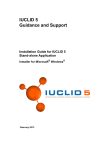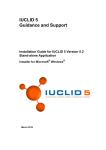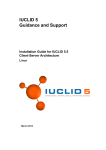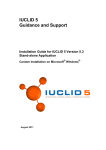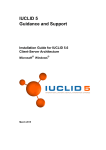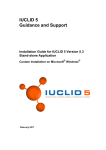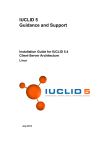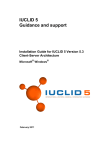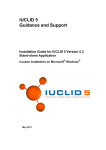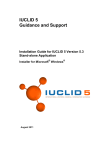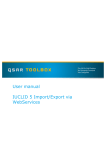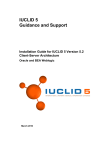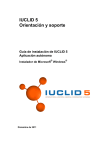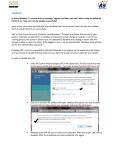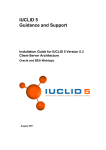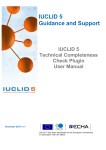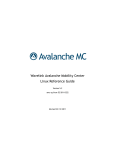Download IUCLID 5 Guidance and Support
Transcript
IUCLID 5
Guidance and Support
Installation Guide for IUCLID 5.5
Standalone Application
®
®
Custom Installation on Microsoft Windows
March 2013
Legal Notice
Neither the European Chemicals Agency nor any person
acting on behalf of the Agency is responsible for the use which might
be made of the following information.
A wealth of additional information on the European Union is available on the Internet.
It can be accessed at the addresses:
http://iuclid.echa.europa.eu.
http://echa.europa.eu.
http://europa.eu.
©European Chemicals Agency
Reproduction is authorised provided the source is acknowledged.
Table of Contents
1. Introduction ............................................................................................................................................... 1
1.1. Hardware requirements .................................................................................................................. 1
1.2. Software requirements ................................................................................................................... 1
2. Making a fresh installation of IUCLID 5 ...................................................................................................... 3
2.1. Installation of the Software Required by IUCLID 5 ............................................................................ 3
2.1.1. Installation of Java .............................................................................................................. 3
2.1.2. Installation of PostgreSQL ................................................................................................... 5
2.1.3. Configuration of PostgreSQL .............................................................................................. 10
2.1.4. Installation and Configuration of Oracle .............................................................................. 15
2.2. Installing IUCLID 5 ....................................................................................................................... 15
2.3. Post-installation configuration ........................................................................................................ 15
2.3.1. Database connection for PostgreSQL ................................................................................. 16
2.3.2. Database connection for Oracle ......................................................................................... 16
2.3.3. Window title ...................................................................................................................... 16
2.3.4. Security settings for user accounts ..................................................................................... 17
2.4. Quick guide to installation and configuration - example for system administrators ............................. 18
3. Upgrade ................................................................................................................................................. 20
3.1. Upgrading from IUCLID 5.4.x to IUCLID 5.5.0 ................................................................................ 20
3.1.1. The migration tool ............................................................................................................. 21
3.1.2. Starting IUCLID 5 .............................................................................................................. 21
3.2. Upgrading from IUCLID 5.2.x/5.3.x to IUCLID 5.5.0 ........................................................................ 22
3.3. Upgrading from IUCLID 5.0/5.1.x to IUCLID 5.5.0 .......................................................................... 22
4. Initialisation of an installation of IUCLID 5 ................................................................................................ 23
4.1. Starting IUCLID 5 ......................................................................................................................... 23
4.2. First steps wizard ......................................................................................................................... 23
4.3. User management ........................................................................................................................ 31
5. Un-installation of IUCLID 5 ...................................................................................................................... 32
iii
Chapter 1. Introduction
IUCLID 5 can be installed either as a stand-alone application, or in a multi-user environment that uses client-server
architecture. The purpose of this document is to describe how to install manually, a single stand-alone application
®
®
version of the IUCLID 5 software onto a computer running Microsoft Windows (hereafter referred to as Windows).
The installation is performed by ensuring that prerequisite software is installed, copying files to the computer and
then, if necessary, making some configuration changes that are explained in this document. If the instructions in
this document are followed exactly, no prior specialist knowledge is required of either the IUCLID 5 software, or the
software components required to run it.
The stand-alone installation of IUCLID 5 should be carried out manually if you want to use a database and version
of Java other than those that are used with the IUCLID 5 installer for Windows. For example, the database Oracle
rather than PostgreSQL.
If you encounter any problems during the installation that cannot be solved using information in this manual, or the
documentation of third party softwares; before contacting ECHA Helpdesk, please try the IUCLID FAQ located at
the IUCLID web site http://iuclid.eu.
1.1. Hardware requirements
The following requirements are provided as only a guide.
• At least 2 GB of RAM on the mother board; 4 GB if PostgreSQL is run on the same machine as IUCLID 5
• Intel Pentium Dual @ 1.8 GHz
• 10 GB of hard-drive space
An installation of IUCLID 5 will most likely run on a lower specified machine but the performance might not be
satisfactory. The requirements depend in part on the version of Windows and the IUCLID 5 plugins that are in use.
For example, using the Query Tool plugin will increase the resources required to obtain a reasonable running speed;
especially on a large database. The handling of large attachments increases the memory requirement.
1.2. Software requirements
The software prerequisites for the installation are as follows:
• Windows preferably with knowledge of the administrator password.
It is recommended to carry out the installation from a standard type of Windows user account, rather than an
administrator. You will be prompted to enter the administrator password where necessary.
• Java SE - Runtime Environment 7. IUCLID 5.5.0 is compatible with Java 6, but the vendor, Oracle, recommends to
uninstall Java SE 6, and then to install the latest update of Java 7. Various scenarios involving the use of IUCLID
5, Java 6 and Java 7 can be found in the IUCLID FAQ located at the IUCLID web site http://iuclid.eu.
• Database - PostgreSQL 8.4 and 9.0 are supported, but 9.0 is recommended; or Oracle 10g or higher. IUCLID 5
works with both PostgreSQL and Oracle, therefore you need to chose which database to use, and then use only
that. You do not need to install both PostgreSQL and Oracle.
The Oracle driver for Java is no longer supplied with the IUCLID 5 installation package. The correct driver for the
combination of Java and Oracle versions in use must be obtained from the Oracle web site and installed in the
appropriate folder. The most recent driver for your version of Oracle should work. For example, for Oracle 11g
Release 2 (11.2.0.2.0), the name of the driver is ojdbc6.jar. For use with Tomcat, the driver must be placed
in Tomcat's library folder, e.g. Tomcat\lib.
1
• A package for the installation of a standalone (workstation) version of IUCLID 5 can be downloaded without charge
from the IUCLID web site.
• Once you have completed the installation of IUCLID 5, you should test it by starting and configuring it. The configuration requires access to at least a legal entity file (LEOX). The creation of a LEOX is described on the IUCLID
web site where the installation software is published. In addition, it is recommended to upload a set of reference
substances and the EC inventory. These are also available from the web site at which the IUCLID 5 software is
published.
Tip
Time and IT resources can be saved by importing into IUCLID 5 only the Reference substances you
need. Various different sizes of Reference substance inventory can be downloaded from the IUCLID
web site. There is a full set, a reduced list, and a function that allows you to create your own inventory
using common identifiers as selection criteria, such as EC Number, and IUPAC name. Before importing the full set, consider carefully whether it is really necessary. Reference substances that are not
imported during the initialisation process can be imported later. A simple compromise is to start with
the reduced list.
For more information regarding system requirements, see the FAQ on the IUCLID web site located at http://iuclid.eu.
2
Chapter 2. Making a fresh installation of
IUCLID 5
If Java and PostgreSQL are already installed, go straight to Section 2.1.3, “Configuration of PostgreSQL”.
2.1. Installation of the Software Required by IUCLID 5
The installation of third party software is described by the respective publishers. Please refer to their web sites for
full instructions.
2.1.1. Installation of Java
1. Verify whether Java (JRE) of the correct version is installed on the computer to which IUCLID 5 will be installed:
Open a command prompt (Start -> Run… -> Open: cmd). At the command prompt, enter the following:
java -version
Figure 2.1. Check version of Java
2. If a message similar to the one shown in the screen shot above is not shown, the system does not have Java SE installed, in which case, download the latest update of Java SE 7 (JRE) from the vendor's site http://www.oracle.com,
and then install it. If the version is "1.6.x", the default version of Windows is Java SE 6 (JRE). IUCLID 5.5.0 is
compatible with Java 6, but the vendor, Oracle, recommends to uninstall Java SE 6, and then to install the latest
update of Java 7. Information relevant to the version of Java used with IUCLID 5 can be found in the IUCLID FAQ
located at the IUCLID web site http://iuclid.eu.
The installation process is illustrated in some example screen shots below.
3
Figure 2.2. Select either the default, or a custom destination for the installation
Figure 2.3. Installation is under way
4
Figure 2.4. Installation of Java is complete
2.1.2. Installation of PostgreSQL
If either version 8.4 or 9.0 of PostgreSQL are already installed and running as a service with a user postgres,
the existing installation can be used. Later versions of PostgreSQL might work, but they are not yet supported. If
PostgreSQL is not already installed on the computer, or you would like to upgrade it, download the new version of
PostgreSQL from the site www.postgresql.org/download and install it. The web site of PostgreSQL offers a range of
alternative ways to download and install the PostgreSQL software. The screen shots shown below show the use of
the one click installer. An example of the file name of the installer is postgresql-9.0.12-2-windows-x64.exe.
The default fresh installation of PostgreSQL, made using the one click installer, automatically starts PostgreSQL
as a service, creates the user postgres if necessary, and supplies administration tools (e.g. pgAdmin III) that can
be used to manage databases. If the installer creates the database superuser postgres, you will have to enter
a password for it into step 4 of the one click installer, as shown in the sequence of figures below. Remember this
password because it will be required later, during the configuration of IUCLID 5. If you are unsure of what values to
enter into the one click installer, use the pre-filled defaults.
5
Figure 2.5. Installer for PostgreSQL
Figure 2.6. Installation directory for PostgreSQL
6
Figure 2.7. Data directory for PostgreSQL
Figure 2.8. Password for the database superuser (postgres) and the Windows service
account (postgres)
7
Figure 2.9. Port number for PostgreSQL
Figure 2.10. Set the default locale for PostgreSQL
8
Figure 2.11. Confirm installation of PostgreSQL
Figure 2.12. Installation of PostgreSQL in progress
9
Figure 2.13. Installation of PostgreSQL complete
Unless you particularly want to run the Stack Builder, untick the box in the screen shown above. To finish the installation, click on the button Finish.
2.1.3. Configuration of PostgreSQL
A new user and a new database need to be created.
Tip
IUCLID 5 is configured by default to connect to the database using username:iuclid5 and
password:iuclid5. It is convenient to specify the same password now, and change it later when the application is set up correctly.
Important
Take note of the password of this user. This user name and password will be needed later to connect
IUCLID 5 to the database.
The program pgAdmin III can be used to create the database as follows. Start pgAdmin III from the menu Start /
All Programs / PostgreSQL9.0. After the splash screen has appeared and you have closed the pop-up window that
shows usage tips, the following screen is shown.
10
Figure 2.14. pgAdmin III interface on first opening
Right-click the text PostgreSQL 9.0 (localhost:5432) that is under the word Servers highlighted in blue in the figure
above. Select connect as shown below.
Figure 2.15. Connect pgAdmin III to PostgreSQL as user postgres
Enter the password for user postgres as given in the postgres installer Figure 2.8, “Password for the database
superuser (postgres) and the Windows service account (postgres)” then click OK. It is recommended to store the
password to facilitate future access.
11
Figure 2.16. Authenticate the user postgres
If you elect to save the password, the following warning might be displayed. Click OK
Figure 2.17. Saving passwords Warning
Expand the tree for PostgreSQL 9.0 (localhost:5432) by clicking the plus sign that has just appeared next to it, as
shown in the figure below.
Figure 2.18. Initial screen in pgAdmin III
12
Right-click on Login Roles and select New Login Role....
Figure 2.19. Select the option New Login Role
Enter the name of the login role. We recommend using a name of iuclid5.
Figure 2.20. Create a new login role (i.e. a user) with the name iuclid5
The login role can have a password set, although this is optional.
Important
Make a note of the user name and if set, the password. They are referred to later in the installation, in
Section 2.3.1, “Database connection for PostgreSQL”. We recommend using iuclid5 as the name of
the login role, and for the value of the password.
13
Request a new database by right-clicking the item Databases, and selecting New Database... as shown in the figure
below.
Figure 2.21. Request a new database in pgAdmin III
Enter the database name and owner. We recommend using a name of iuclid followed by the version number, for
example iuclid550. Select the owner to be the value used in the previous step, e.g. iuclid5. The encoding must
be left at the default value of UTF8. Click OK.
Important
Make a note of the database name. It is referred to later in the installation, in Section 2.3.1, “Database
connection for PostgreSQL”.
Figure 2.22. Enter the details of IUCLID 5's database into pgAdmin III
14
As you can see from the figure below, there is now a new database named iuclid550.
Figure 2.23. List of databases in pgAdmin III
You can now close pgAdmin III and move directly to the installation of IUCLID 5.
2.1.4. Installation and Configuration of Oracle
The installation and configuration of an Oracle database are out of the scope of this document. For full details, consult
the documentation supplied by the vendor. Information specific to IUCLID is given in the IUCLID installation manual,
Client-Server Architecture (Oracle®), which is available from the same site as this manual.
The configuration of the connection between an Oracle database and IUCLID 5 is described later in this document
in Section 2.3.2, “Database connection for Oracle”.
2.2. Installing IUCLID 5
Unzip the archive that contains the software for the manual installation of IUCLID 5. Do not unzip or change the
relative location of any of the plugin archives. Create an installation directory for IUCLID 5 somewhere convenient (for
example C:\Program Files\IUCLID5). Copy the directory workstation and all its contents into the installation
directory.
2.3. Post-installation configuration
If you are making a fresh installation of IUCLID 5, using PostgreSQL for the database, and only the default values
suggested in this document, IUCLID 5 should start without any additional configuration. Otherwise, it is necessary
to set values for parameters in the file workstation.properties, that is located in a folder named conf within
the installation folder. Values set in the file over-ride hard-coded defaults. Parameters for which you do not want to
set your own values should be commented out by placing the symbol # at the start of the line. The meanings of the
parameters and their default configurations are described in the sub-sections below.
Tip
If you experience difficulties in saving changes to the properties file, try granting write access for it,
to standard local users. This can be done by right-clicking on the file, selecting properties / security,
15
highlighting your user group or user name, then ticking the box allow for write. You will need to supply an
administrator password. The write permission can be revoked after your IUCLID 5 has been successfully
configured.
2.3.1. Database connection for PostgreSQL
This is where the values used to connect IUCLID 5 to a PostgreSQL database are defined. Usually, only the first three
values need to be considered. These define the name of the database, the login role (username) and its password,
as shown below.
# --------------------------# Settings for using PostgreSQL
# --------------------------hibernate.connection.url=jdbc:postgresql://localhost:5432/<database>
hibernate.connection.username=<username>
hibernate.connection.password=<password>
hibernate.connection.driver_class=org.postgresql.Driver
hibernate.dialect=org.hibernate.dialect.PostgreSQLDialect
The default values are shown below.
# --------------------------# Settings for using PostgreSQL
# --------------------------hibernate.connection.url=jdbc:postgresql://localhost:5432/iuclid550
hibernate.connection.username=iuclid5
hibernate.connection.password=iuclid5
hibernate.connection.driver_class=org.postgresql.Driver
hibernate.dialect=org.hibernate.dialect.PostgreSQLDialect
2.3.2. Database connection for Oracle
This is where the values used to connect IUCLID 5 to an Oracle database are defined. The default values are shown
below. Uncomment the lines as required.
# --------------------------# Settings for using ORACLE 10g
# --------------------------#hibernate.connection.username=<username>
#hibernate.connection.password=<password>
#hibernate.connection.driver_class=oracle.jdbc.driver.OracleDriver
#hibernate.connection.url=jdbc:oracle:thin:@localhost:1521:<database>
#hibernate.hbm2ddl.auto=validate
#hibernate.dialect=eu.eca.iuclid.server.system.persistence.ExtendedOracle9Dialect
#hibernate.jdbc.use_streams_for_binary=false
2.3.3. Window title
It is possible to define a name that is displayed at the top left of the IUCLID 5 interface. Enter the name into the value
of the parameter shown below. The default value is shown below. Uncomment the line as required.
16
# --------------------------# configurable default window title
# overrides the title defined in the source code
# --------------------------#connection.client.window.title=IUCLID 5.5.0
2.3.4. Security settings for user accounts
IUCLID 5 has features designed to control the level of security of authentication of user accounts. The level of security
can be tailored to that required for the particular installation of IUCLID 5. For example, when setting passwords for
their user accounts, users can be forced to enter values that have a minimum strength. The values of the parameters
that determine the level of security are defined in the settings file, workstation.properties, that is located in a
folder named conf within the installation folder. Changes to values take effect on restarting IUCLID 5. The security
features are described below.
The settings are shown below as they appear in the settings file that is supplied with the installation of IUCLID 5. The
values are shown set to the hard-coded defaults and commented out. If a line is commented out, the hard-coded
default value is used. A value of zero (0) disables a feature.
#
#
#
#
#
#
The minimum length for a new password
password.min.length=6
The minimum number of character sets used in the password
password.min.charsets=2
If a secure question system is enabled
password.use.secure.question=true
In the example shown below, the security features have been disabled.
# The minimum length for a new password
password.min.length=0
# The minimum number of character sets used in the password
password.min.charsets=0
# If a secure question system is enabled
password.use.secure.question=0
2.3.4.1. Minimum password length
This feature is used to prevent the use of overly weak passwords for user accounts. The password of a user account
must contain at least this number of characters. If an attempt is made to create a password with fewer characters,
an informative error message is given and the user is presented with an opportunity to try again.
The security policy is applied to passwords only when they are created. Therefore, if the minimum length of passwords
is increased, users can still log in using existing passwords, even if they are now considered to be too short. The
user-manager can force a user to create a new password by ticking a box for the account in the IUCLID 5 client. The
user is then required to create a new password when they next log in.
2.3.4.2. Minimum number of character sets in passwords
This feature is used to prevent the use of overly weak passwords for user accounts. The password of a user account
must contain at least one character from all the character sets. The value is an integer from 1 to 4. A value of 1 means
only character set 1, a value of 2 means both character sets 1 and 2, etc. The four character sets are: 1 = a lowercase
letter [a-z], 2 = an uppercase letter [A-Z], 3 = a digit [0-9], 4 = a non-alphanumeric symbol [!@#$%^&*-_=+].
For example, if the value is 3, a password of "AdkbScfw" is rejected for being too weak, but "AdkbSc37" is accepted
because it contains at least one character from sets 1, 2 and 3.
17
If an attempt is made to create a password that does not comply, an informative error message is given, and the
user is presented with an opportunity to try again.
The security policy is applied to passwords only when they are created. Therefore, if the minimum number of character
sets allowed within passwords is increased, users can still log in using existing passwords, even if they are now
considered to contain too few character sets. The user-manager can force a user to create a new password by ticking
a box for the account in the IUCLID 5 client. The user is then required to create a new password when they next log in.
2.3.4.3. Security question
This feature is designed to allow an alternative method of user authentication to the user name/password combination. It can help to reduce the resources required for user management by preventing account blocking due to
forgotten passwords. Each user can define their own security question and a secret answer. This is done from the
graphical user interface of the client, after the user has logged in. A user can log in by answering their question
correctly, instead of supplying the password. The question is answered via a link on the log in page, Forgot your
password?. The feature is turned on or off for the whole instance of IUCLID 5 using a value of true or false.
2.4. Quick guide to installation and configuration example for system administrators
What follows is an example of a check list of the sequence of actions required to make a fresh installation of IUCLID 5.
It assumes that the user has administrator rights to the installation machine, and experience of system administration
under Windows.
1. Install the latest update of Java SE 7 (JRE) for your version of Windows, available without charge within the limits
of the license, from the site www.java.com.
2. Download the latest one-click installer for PostgreSQL for your version of Windows. It is available without charge,
within the limits of the license, from www.postgresql.org/download. Run the installer. If a Windows user postgres
does not exist already, the installer wizard will create one and ask you to give it a password. Remember the
password for subsequent steps.
3. Create a database login role (user) named iuclid5. Create a database named iuclid550 under that login role.
Remember the values for subsequent steps. A convenient way to do this is using the graphical admin tool pgAdmin
III that comes with PostgreSQL.
4. Create an installation directory for IUCLID 5 somewhere convenient, for example C:\Program Files\IUCLID5.
5. Copy into the installation directory, all the contents of the directory named workstation supplied in the zipped
archive of the IUCLID 5 download. Do not unzip any of the plugin files.
6. Set the values for the username and password of the PostgreSQL database user (login role) as defined above.
The values are stored in the file named, workstation.properties that is located in a folder named conf
within the installation folder. The default values are as follows:
hibernate.connection.username=iuclid5
hibernate.connection.password=iuclid5
7. Set the values for the level of security for user accounts, as described in Section 2.3.4, “Security settings for user
accounts”.
8. Start IUCLID 5 by running the executable file iuclid5.cmd from the installation directory. If IUCLID 5 does not
run first time, check that PostgreSQL is running as a service and that there is a user named postgres.
18
9. When an installation of IUCLID 5 is started for the first time, the wizard First Steps is launched. It is designed to
help in the set-up of the installation. Go through the steps of the wizard. Detailed help is available via links denoted
by a question mark, ? at the bottom left of the wizard pages.
10.If the installation has been a success, create any links to iuclid5.cmd you might require, for example a shortcut
from the Desktop. There is an icon in the installation folder that you can use with a shortcut.
19
Chapter 3. Upgrade
This document describes the process of obtaining an installation of IUCLID 5.5.0 that contains all the data from a
previous version. The details of how to proceed depend on the version being upgraded. There is a chapter specific
to each scenario. To see the current version of IUCLID 5, log-in to the application, then click Help and select About.
Before starting the upgrade, it is important to backup the database. Use the built-in Backup functionality of IUCLID 5,
and/or the backup functionality of the database. Making only a copy of the file system on which IUCLID 5 is installed
is not recommended as a means of backing-up.
3.1. Upgrading from IUCLID 5.4.x to IUCLID 5.5.0
Important
The migration process changes the IUCLID 5 database such that it can no longer be used with previous
versions of the IUCLID 5 application. Therefore, if you would like to be able to continue to use a database with the previous version of IUCLID 5, do not run the migration tool on that particular database.
Either perform a fresh installation of the new version of IUCLID 5 and transfer the data across to it using Backup/Restore, or perform the upgrade and migration on a duplicate of the old database. If two
versions of IUCLID 5 are to be run on the same computer, appropriate database settings must be used
to avoid conflicts. These depend on the particular set-up required. The use of custom database settings
is described in Section 2.3, “Post-installation configuration”.
The upgrade is carried out in the following sequence:
1. Back-up the database. Use the built-in Back-up functionality of IUCLID 5, and/or the backup function of the database software, for example PostgreSQL.
2. Remove the executable program files for the previous version of IUCLID 5. The existing plugins for IUCLID 5.4.x
are compatible with IUCLID 5.5, so they can be retained for use in the new installation. Alternatively, obtain the
latest versions from the IUCLID web site.
3. Install the program files for the latest version of IUCLID 5.5 as follows. Unzip the archive that contains the software
for the manual installation of IUCLID 5. Create an installation directory for IUCLID 5 somewhere convenient, for
example C:\ Program Files \ IUCLID5. Copy the directory workstation and all its contents into the
installation directory.
4. Transfer the required information from the existing configuration files to the versions supplied in the new installation. See Section 2.3, “Post-installation configuration” for more details.
Note that if the Oracle database is used, the file workstation.properties must contain the following entry:
hibernate.connection.driver_class=oracle.jdbc.OracleDriver
The previous value was:
hibernate.connection.driver_class=oracle.jdbc.driver.OracleDriver
5. If the database is an Oracle database, please note that the driver for Java is no longer supplied with the IUCLID
installation package. The correct driver for the combination of Java and Oracle versions in use must be obtained
from the Oracle web site and installed in the appropriate folder. For example, for Oracle 11g Release 2 (11.2.0.2.0),
the name of the driver is ojdbc6.jar.
6. Copy any required plugins over from the old installation to the new one. Alternatively, obtain the latest versions
from the IUCLID web site.
20
7. A migration process is required to upgrade to IUCLID 5.5. Migrate the database by running the migration tool,
as described below. This is a script that is supplied along with the installation package. It makes changes to
the database that are required for IUCLID 5.5. IUCLID 5 cannot be started until the migration tool has been run
successfully.
8. Once the migration process has been completed successfully, the new version of IUCLID 5 can be started and
checked before being entered into production.
3.1.1. The migration tool
The migration tool is a script supplied with the installation package. The file name is update.bat. Run the script
as you would any other script either from the command line, or by double-clicking on its icon in the Windows file
manager. Whilst the migration tool is running, a window is shown for the program cmd that contains a terminal to the
command line of Windows. A typical example is shown in the screen shot below:
Figure 3.1. Migration tool is running
Do not allow anything to happen that might interrupt this process. Do not close the window. When the migration of
data has finished, the message Database update successfully finished is displayed in the window. The database is
then checked automatically and final changes are made. At the end of the process, the final message is Database
is up to date. The command line window then closes automatically. If the process is interrupted, try starting again
from the beginning. If that does not work, restore the original database from a backup, and try again. During the
migration process, entries are written to log files named i5workstation.log and iuclidMT.log. The default
path to the log files is ${user.home}/.iuclid5/. In practice, this leads to a value such as C:\Documents and
Settings\<user name>\.iuclid5 where <user name> is the name of the user account in Windows that is
used to run IUCLID 5. The file i5workstation.log contains statements about the start and end of the migration
process. Details of what data is being migrated are included in iuclidMT.log. If you need to know what happened
during the migration process, check those files first.
3.1.2. Starting IUCLID 5
If the migration tool has run successfully, you can now launch the newly installed IUCLID 5.5 by double-clicking the
icon that the installer created on your Desktop, as shown below. It is also possible to launch IUCLID 5 by running
the file iuclid5.cmd that is included in the installation directory. The initialisation process is not required. All of the
data that was present in the upgraded system should be present in the new system. Therefore, it should be possible
to log in to any of the user accounts from the previous system.
21
Figure 3.2. A shortcut to the IUCLID 5 application
3.2. Upgrading from IUCLID 5.2.x/5.3.x to IUCLID
5.5.0
To upgrade from IUCLID versions 5.2.x or 5.3.x, unless the database contains a very large amount of data, it is
recommended to use the Backup and Restore features of IUCLID 5 to transfer the data from the old installation to a
fresh installation of IUCLID 5.5.0. The Backup and Restore features are described in the IUCLID 5 End-User Manual.
Making a fresh installation is described in this manual.
Warning
The built-in Backup functionality of IUCLID 5.3.1 is known to output files in which the user accounts
cannot be used on restore. If you wish to use the built-in Backup functionality on data in an installation
of IUCLID 5.3.1, first upgrade it to IUCLID 5.3.2. The built-in Backup functionality in IUCLID 5.3.2 does
not suffer from this problem.
As an alternative to using Backup and Restore into a fresh installation, it is possible to perform step-wise upgrades in
which the database is migrated from IUCLID 5.2.x/5.3.x to 5.4.x to 5.5.0. For example, this method might be required
if the amount of data is so large that it makes use of the Backup feature impractical. If you choose the migration
method, obtain the installation packages to perform the required upgrades, and then proceed as per the instructions
included therein.
Note that the plugins for IUCLID 5.2.x/5.3.x are not compatible with IUCLID 5.5. Therefore, they must not be copied
over to the new installation. Compatible versions can be downloaded from the IUCLID web site.
3.3. Upgrading from IUCLID 5.0/5.1.x to IUCLID 5.5.0
To upgrade from 5.0/5.1.x, no migration process is available, and so the method of using Backup then Restore into
a fresh installation must be used. In IUCLID 5.0/5.1.x there is no built-in Backup function. Instead, the functionality is
provided by a plugin, Backup Plug-in 5.0.3 that is available on the IUCLID web site under downloads for IUCLID 5.1.1.
22
Chapter 4. Initialisation of an installation of
IUCLID 5
This chapter describes the configuration that is required to create a working IUCLID 5 system from an installation of
IUCLID 5 that has an empty database. There are two scenarios: either to create a working installation from scratch,
or to load data from a backup that was made using the built-in Backup function of IUCLID 5. During initialisation from
scratch, reference substance data and a legal entity are uploaded into the database, and the required user accounts
can be created. For initialisation from a backup, make sure that the backup files are accessible from the system on
which IUCLID 5 will be initialised. What to do in each scenario is described in the rest of this chapter.
4.1. Starting IUCLID 5
Connect to the application by running the file named iuclid5.cmd that is supplied with the installation files. It is
convenient to create a shortcut that points to iuclid5.cmd and to attach the IUCLID 5 icon that is supplied with
the installation files.
Figure 4.1. A shortcut to the IUCLID 5 application
4.2. First steps wizard
When you start IUCLID 5 for the first time, the First steps wizard is run automatically. It guides you through the steps
required to make a working user account and to upload the data required to use IUCLID 5 in a practical setting. The
settings that relate to user accounts can also be changed after having run the wizard, using the features described
in the IUCLID 5 End-user Manual.
Important
This wizard allows a single user account to be created, per run. This user is in addition to the SuperUser
account that comes with the installation. It is essential to have at least one user account in addition to
SuperUser because SuperUser should be used only for the special tasks that only it can carry out. See
the IUCLID 5 End-user Manual for more detail.
As part of the First steps wizard, a legal entity must be uploaded into the IUCLID 5 installation in the form
of a LEOX file. Therefore, before running this wizard, make sure that a LEOX file for the legal entity of
your company or organisation is accessible to your computer. For more information, see the IUCLID 5
End-user Manual.
The First steps wizard provides the option of uploading the following information to your IUCLID 5 installation. For details, see the IUCLID 5 End-user Manual:
• EC Inventory
• Inventory of Reference substances
Although these uploads are optional, it is strongly recommended to do them during the first run of the
First steps wizard. To do so, you will need to have the data accessible to your computer whilst running
this wizard.
23
The First steps wizard can be run at any time, but only by the SuperUser. This is done from the file menu within
IUCLID 5 Administrative tools / Initialise.
When starting the IUCLID 5 for the first time, the only user available is an administrator named SuperUser. Log in
as SuperUser by entering the following case-sensitive values into the login screen as shown below:
Username: SuperUser
Password: root
Note
Do not click on the link Forgot your password? if the First steps wizard is being run for the first time on
this database. This feature can work only after the wizard has been completed. The use of the feature
Forgot your password? is explained later in this wizard, at step 3.
The First steps wizard then proceeds. Each page of the wizard is described in a figure below.
Figure 4.2. Step 1 of the First steps wizard - Introduction
The wizard presents some useful information. There are no actions other than to read the information. Click the
Next button.
24
Figure 4.3. Step 2 of the First steps wizard - Init mode - New installation
To initialise a new database, select the button New Installationas shown below and continue to the next step.
Figure 4.4. Step 2 of the First steps wizard - Init mode - Restore from backup
To restore from a backup of a previous version of IUCLID 5, select the button Restore from backup then enter
the directory containing the backup files as shown in the example below.
Click Next. The wizard jumps to its last step, where the importation of data is started, as shown below.
Figure 4.5. Restoration from a backup - Step 8 - Activate imports
The import may take some time. Click Finish. When the restoration is complete, the following screen is shown.
25
Figure 4.6. Step 3 of the First steps wizard - Change password
If the password for SuperUser has never been changed from its default value of root, the traffic light in the wizard
screen will be yellow. To change the password, check the box Change SuperUser password , enter the current
password, and then the new password, and then the new password again.
To proceed, click the button Next.
Tip
IUCLID 5 has a feature that can check the strength of passwords. If the feature is turned on, and the
password you enter is considered to be too weak, an error message is displayed that explains what a
password must contain. If that happens, read the error message carefully then create a password that
satisfies the criteria. For example, the default settings require the password to be at least 6 characters
in length, and to contain at least one uppercase letter, and one lowercase letter. The policy for the
SuperUser is the same as that for all users. The password policy is set by editing a settings file within
the installation files of IUCLID 5. This is documented in the relevant installation manual for your instance
of IUCLID 5. Existing passwords can still be used to log in, even if they do not conform to the current
policy. When a password is created, it must conform to the current password policy.
Tip
IUCLID 5 has a feature that allows a user to log in by answering a security question, instead of providing
the password for the account. Users define their own questions and answers from within their own
accounts. However, the SuperUser is a special case, because the question and answer can be defined
before logging in for the first time. The question and answer are entered into the fields shown above in
step 3 of the wizard. To use the feature to log in, a user clicks on the link Forgot your password? which
is situated at the bottom right of the login page.
26
Figure 4.7. Step 4 of the First steps wizard - Import Legal Entity
To import a Legal entity (see the IUCLID 5 End-user Manual) select its LEOX file by browsing to the file. The browsing
is accessed by clicking on the folder icon to the right of the field Select the import file. Click the Next button. The
Legal entity is imported immediately.
Important
You must import at least one Legal entity in order to succeed with this wizard. If you have no Legal entity
in the IUCLID 5 system, the traffic light in the wizard screen will be red. The First steps wizard will be
automatically launched when you log in to IUCLID 5 until a Legal entity has been successfully imported.
Figure 4.8. Step 5 of the First steps wizard - Import EC Inventory
EC inventory import - To import the EC inventory, select the file for the EC inventory (see the IUCLID 5 End-user
Manual). The EC Inventory will not be imported immediately. The import will start at the end of the First steps wizard.
Depending on your machine speed and the size of the inventory, this import can take some time, e.g. up to half
an hour.
27
Figure 4.9. Step 6 of the First steps wizard - Import reference substance inventory
Reference substance inventory import - Select the file for the Reference substance inventory (see the IUCLID 5 Enduser Manual). The Reference substance inventory will not be imported immediately. The import will start at the end
of the first steps wizard together with the EC Inventory import. Depending on your machine speed and the size of
the inventory, this bulk operation may take a long time. The import of the Reference substance inventory itself can
take up to several hours.
Tip
Time and IT resources can be saved by importing into IUCLID 5 only the Reference substances you
need. Various different sizes of Reference substance inventory can be downloaded from the IUCLID web
site. There is a full set, a reduced list, and a function that allows you to create your own inventory using
common identifiers as selection criteria, such as EC Number, and IUPAC name. Before importing the full
set, consider carefully whether it is really necessary. Reference substances that are not imported during
the initialisation process can be imported later. A simple compromise is to start with the reduced list.
28
Figure 4.10. Step 7 of the First steps wizard - Create user account and assign role
Create a new user account and define its user access rights by assigning it a role. It is essential to create a new
user because general working within IUCLID 5 with the SuperUser is not supported. Only one user can be created
per run of the First steps wizard.
• Select the checkbox Create user.
Fill in all the fields. The user needs a Login name for identification during login. The Full name is used for
proper user identification. The Assigned role is needed to administrate the access permissions. In a newly
installed IUCLID 5, the roles Administrator, Full access and Read-only are provided by default.
• Enter a Login name, as it should be used for identification during login, and the Full name used for proper
user identification.
• Click Set password to define a password.
Tip
IUCLID 5 has a feature that can check the strength of passwords. If the feature is turned on, and the
password you enter is considered to be too weak, an error message is displayed that explains what
a password must contain. If that happens, read the error message carefully then create a password
that satisfies the criteria. For example, the default settings require the password to be at least 6 characters in length, and to contain at least one uppercase letter, and one lowercase letter. The policy for
the SuperUser is the same as that for all users. The password policy is set by editing a settings file
29
within the installation files of IUCLID 5. This is documented in the relevant installation manual for your
instance of IUCLID 5. Existing passwords can still be used to log in, even if they do not conform to the
current policy. When a password is created, it must conform to the current password policy.
Tip
If you want a use-once password that is reasonably hard to guess and that definitely conforms to the
password policy, you can let IUCLID 5 make one for you, by clicking on the button Generate. It will be
displayed in a new window for you to make a record of it. On closing that window it will be automatically
entered into the fields New password and Confirm new password.
• Ticking the box Expire password upon next login forces whoever logs in to the account first to set their own
password.
• Click and highlight a role in the list of unassigned roles and assign it to the user by clicking the Right arrow. Assigning
a Role is needed to administrate the access permissions (in a newly installed IUCLID 5, the roles Administrator,
Full access and Read-only are provided by default).
Tip
It is recommended to create a user with the Administrator Role regardless of whether a stand alone or
a distributed version of IUCLID 5 is set up. Once a user has been created, the IUCLID 5 administrator
(in case of a distributed version) can define different other user(s) and assign different role(s) to them
(see the IUCLID 5 End-user Manual).
• Assign a Legal entity (normally the Legal entity imported in the third step of this wizard) by clicking the green plus
button and performing a search for the desired Legal entity. In the Query field Legal entity name, enter the
name of the desired Legal entity or an asterisk (*) as wildcard and click the Search button. In the Query results
list, click the desired entry and then click the Assign button.
• Optionally, select default attachment and import/export directories. These settings can be changed at a later stage,
as described in the IUCLID 5 End-user Manual.
• Click the Next button
Figure 4.11. Step 8 of the First steps wizard - Start import procedure
If you have selected an EC Inventory and/or Reference substances inventory file(s) during the wizard steps, you can
now run the imports. Click the button Execute imports. Note again that these imports can take up to several hours,
depending on your machine speed and the amount of data you are importing.
Then click the button Finish. If you have launched any imports, you will now have to wait until the imports are
completed. Afterwards, you should log out and then log in again as a user for the newly defined account. Remember:
general working as SuperUser is not supported.
30
4.3. User management
The installation of IUCLID 5 is now ready for hand-over to whoever will be maintaining the system and whoever will
be managing the user accounts. The management of user accounts and their roles is described in the IUCLID 5
User Manual.
31
Chapter 5. Un-installation of IUCLID 5
The un-installation of IUCLID 5 is a manual process. IUCLID 5 can be un-installed by deleting the files that were
copied to the destination machine, and reversing any changes made during the installation process. For more details
about the actions that might be required, see the IUCLID FAQ located at the IUCLID web site http://iuclid.eu.
32



































